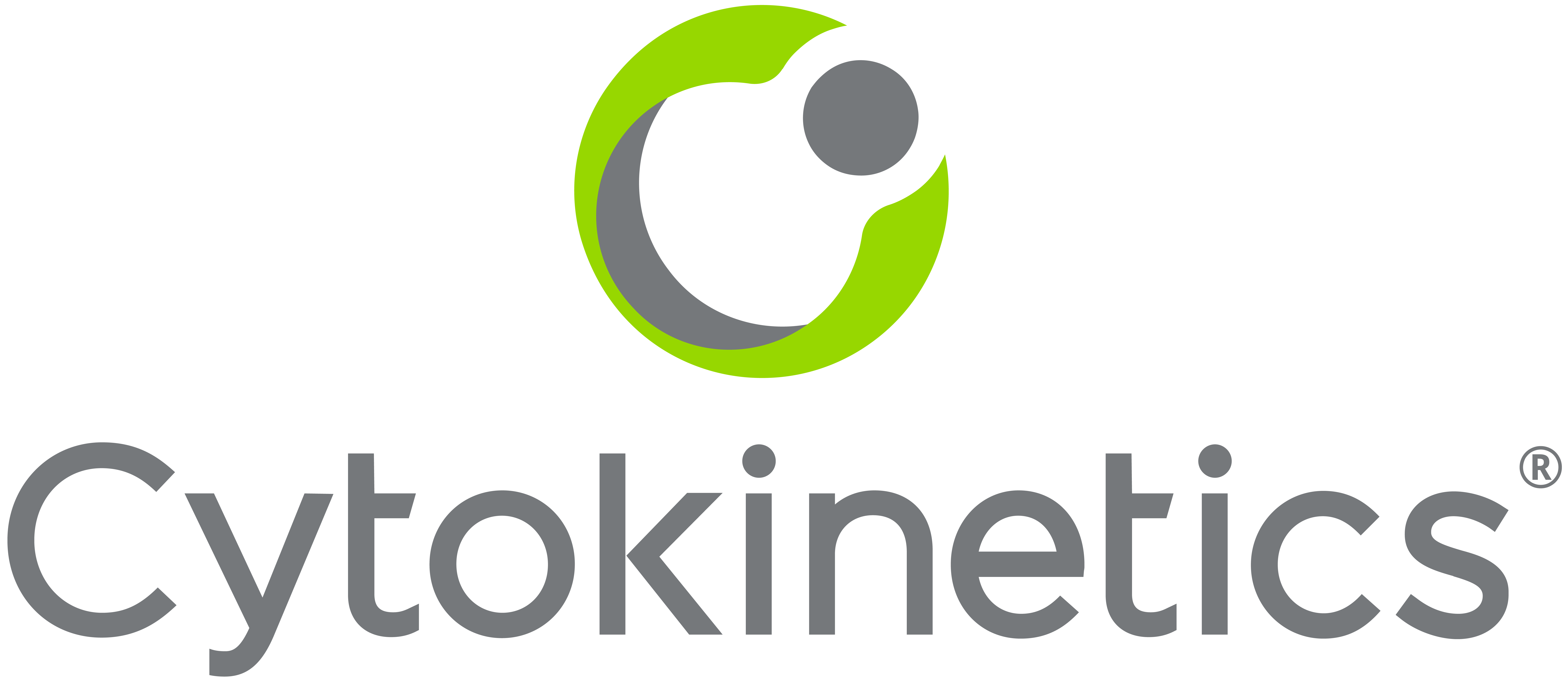Cytokinetics Announces Positive Topline Results of REDWOOD-HCM
Phase 2 Clinical Trial of CK-274 Demonstrated Consistent and Clinically Meaningful Reductions in Left Ventricular Outflow Tract Gradients Within Two Weeks in Patients with Obstructive Hypertrophic Cardiomyopathy
No Treatment Interruptions or Discontinuations Due to Reduction in Left Ventricular Ejection Fraction
Phase 3 Registrational Trial of CK-274 Expected to Start Before Year End
Company to Host Conference Call and Webcast Today at
Results from Cohorts 1 and 2 of REDWOOD-HCM demonstrated that treatment with CK-274 for 10 weeks resulted in statistically significant reductions from baseline compared to placebo in the average resting left ventricular outflow tract pressure gradient (LVOT-G) (p=0.0003, p=0.0004, Cohort 1 and Cohort 2, respectively) and the average post-Valsalva LVOT-G (p=0.001, p<0.0001, Cohort 1 and Cohort 2, respectively). The majority of patients treated with CK-274 (78.6% in Cohort 1 and 92.9% in Cohort 2) achieved the target goal of treatment, defined as resting gradient <30 mmHg and post-Valsalva gradient <50 mmHg at Week 10 compared to placebo (7.7%). Reductions in LVOT-G occurred within two weeks of initiating treatment with CK-274, were maximized within two to six weeks of the start of dose titration, and were sustained until the end of treatment at 10 weeks. The observed reductions in LVOT-G were dose dependent, with patients achieving greater reductions of LVOT-G with increasing doses of CK-274.
Treatment with CK-274 in REDWOOD-HCM was generally well tolerated. The incidence of adverse events was similar between treatment arms. No serious adverse events were attributed to CK-274 and no treatment interruptions occurred on CK-274. No new cases of atrial fibrillation in patients treated with CK-274 were reported. In this dose-range finding trial, one patient experienced a transient decrease in left ventricular ejection fraction (LVEF) that required dose adjustment but not dose interruption. LVEF returned to baseline within two weeks after the end of treatment in both cohorts, which was consistent with the reversibility of LVEF decreases that were similarly observed in healthy participants in the Phase 1 study of CK-274.
“The combined data from Cohorts 1 and 2 in REDWOOD-HCM met our high expectations for this trial of CK-274 in patients with obstructive HCM, given the observed onset of response to initiation of treatment, magnitude and breadth of response, reversibility of LVEF decreases and favorable tolerability profile,” said
“We are pleased to see the impressive results in terms of substantial reduction of outflow tract gradient from REDWOOD-HCM and the clinically relevant combination of efficacy and safety findings and reversibility of effect evident from treatment with CK-274,” said
REDWOOD-HCM: Clinical Trial Design
REDWOOD-HCM is a multi-center, randomized, placebo-controlled, double-blind, dose finding clinical trial of CK-274 in patients with symptomatic obstructive HCM (oHCM) on background medical therapy. The primary objective of the trial is to determine the safety and tolerability of CK-274. The secondary objectives are to describe the concentration-response relationship of CK-274 on the resting and post-Valsalva left ventricular outflow tract gradient as measured by echocardiography during 10 weeks of treatment, to describe the dose response relationship of CK-274, and to evaluate the plasma concentrations of CK-274 in patients with oHCM. Seventeen investigative sites in
Topline results from REDWOOD-HCM include data from two sequentially conducted cohorts, Cohort 1 (n=21) and Cohort 2 (n=20) which randomized treatment of patients 2:1 to CK-274 or placebo. Patients received up to three escalating doses of CK-274 once daily (5, 10, 15 mg in Cohort 1 and 10, 20, 30 mg in Cohort 2) or placebo. Patients had an echocardiogram after two weeks of treatment at each dose to determine potential up-titration to the next higher dose. Overall, treatment duration for each patient in REDWOOD-HCM was 10 weeks with an echocardiogram conducted 2 weeks after the last dose.
REDWOOD-HCM: Topline Results
For patients on CK-274 in Cohort 1 (n=14), the average resting LVOT-G changed from 53.8 mmHg at baseline to 13.4 mmHg at 10 weeks; for patients on CK-274 in Cohort 2 (n=14) the average resting LVOT-G changed from 58.2 mmHg at baseline to 15.1 mmHg at 10 weeks; and for patients in the combined placebo group (n=13) the average resting LVOT-G changed from 52.1 at baseline to 44.0 mmHg at 10 weeks (Figure 1, p=0.0003 for Cohort 1, p=0.0004 for Cohort 2 in comparison to placebo at 10 weeks).
A photo accompanying this announcement is available at https://www.globenewswire.com/NewsRoom/AttachmentNg/46013660-2ce0-4569-871d-1708d39140b0
For patients on CK-274 in Cohort 1 (n=14) the average Valsalva LVOT-G changed from 74.4 mmHg at baseline to 38.1 mmHg at 10 weeks; for patients on CK-274 in Cohort 2 (n=14) the average Valsalva LVOT-G changed from 82.3 mmHg at baseline to 29.8 mmHg at 10 weeks; and for patients in the combined placebo group (n=13) the average Valsalva LVOT-G changed from 84.6 at baseline to 76.0 mmHg at 10 weeks (Figure 2; p=0.001 for Cohort 1, p<0.0001 for Cohort 2 in comparison to placebo at 10 weeks).
A photo accompanying this announcement is available at https://www.globenewswire.com/NewsRoom/AttachmentNg/9aca65d5-6f6e-44d5-8439-323e8c93c0f2
The average ejection fraction for patients on CK-274 in Cohort 1 (n=14) changed from 73.2% at baseline to 67.4% at 10 weeks; for patients on CK-274 in Cohort 2 (n=14) the average ejection fraction changed from 75.4% at baseline to 64.1% at 10 weeks, and for patients in the combined placebo group (n=13) the average ejection fraction changed from 74.5% at baseline to 74.9% at 10 weeks (p=0.007 for Cohort 1, p=<0.0001 for Cohort 2 in comparison to placebo at 10 weeks).
Overall, the incidence of adverse events was similar between treatment arms. Treatment with CK-274 in REDWOOD-HCM was generally well tolerated in patients being treated with current standard of care with adverse events reported as mild or moderate in severity. There were no treatment related serious adverse events reported by investigators.
No patients who received CK-274 in Cohort 1 had an LVEF <50%. In Cohort 2, one patient with an LVEF at baseline of 58% was up-titrated to 20 mg of CK-274 and experienced transient LVEF reduction to <50% (remaining above 40%) requiring down titration. No interruptions or discontinuations of treatment with CK-274 occurred in any patients across both cohorts.
The distribution (Table 1) of patients across doses of CK-274 in REDWOOD-HCM informs dose selection for the planned Phase 3 trial with the objective to assess clinical outcomes at the lowest effective individualized dose of CK-274.
Table 1
| Final Dose Achieved (N) | |||||||
| Cohort 1 | Cohort 2 | ||||||
| Placebo | 5 mg | 10 mg | 15 mg | 10 mg | 20 mg | 30 mg | |
| Cohort 1+2 (N=41) | 13 | 4 | 5 | 5 | 9 | 4 | 1 |
Results of REDWOOD-HCM will be submitted to a future medical conference and for publication.
Conference Call and Webcast Information
Members of
An archived replay of the webcast will be available via
About CK-274
CK-274 is a novel, oral, small molecule cardiac myosin inhibitor that company scientists discovered independent of its collaborations. CK-274 arose from an extensive chemical optimization program conducted with careful attention to therapeutic index and pharmacokinetic properties that may translate into next-in-class potential in clinical development. CK-274 was designed to reduce the hypercontractility that is associated with hypertrophic cardiomyopathy (HCM). In preclinical models, CK-274 reduced myocardial contractility by binding directly to cardiac myosin at a distinct and selective allosteric binding site, thereby preventing myosin from entering a force producing state. CK-274 is designed to reduce the number of active actin-myosin cross bridges during each cardiac cycle and consequently reduce myocardial contractility. This mechanism of action may be therapeutically effective in conditions characterized by excessive hypercontractility, such as HCM.
The overall development program will assess the potential of CK‑274 to improve exercise capacity and relieve symptoms in patients with hyperdynamic ventricular contraction due to HCM.
About Hypertrophic Cardiomyopathy
Hypertrophic cardiomyopathy (HCM) is a disease in which the heart muscle (myocardium) becomes abnormally thick (hypertrophied). The thickening of cardiac muscle leads to the inside of the left ventricle becoming smaller and stiffer, and thus the ventricle becomes less able to relax and fill with blood. This ultimately limits the heart’s pumping function, resulting in symptoms including chest pain, dizziness, shortness of breath, or fainting during physical activity. A subset of patients with HCM are at high risk of progressive disease which can lead to atrial fibrillation, stroke and death due to arrhythmias. There are no FDA approved medical treatments that directly address the hypercontractility that underlies HCM.
About
For additional information about Cytokinetics, visit www.cytokinetics.com and follow us on Twitter, LinkedIn, Facebook and YouTube.
Forward-Looking Statements
This press release contains forward-looking statements for purposes of the Private Securities Litigation Reform Act of 1995 (the “Act”).
Contact:
Senior Vice President, Corporate Communications, Investor Relations
(415) 290-7757
Source: Cytokinetics, Incorporated






